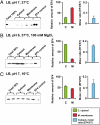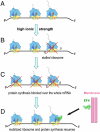Elongation factor 4 (EF4/LepA) accelerates protein synthesis at increased Mg2+ concentrations
- PMID: 21300907
- PMCID: PMC3044372
- DOI: 10.1073/pnas.1012994108
Elongation factor 4 (EF4/LepA) accelerates protein synthesis at increased Mg2+ concentrations
Abstract
Elongation factor 4 (EF4) is one of the most conserved proteins present in bacteria as well as in mitochondria and chloroplasts of eukaryotes. Although EF4 has the unique ability to catalyze the back-translocation reaction on posttranslocation state ribosomes, the physiological role of EF4 remains unclear. Here we demonstrate that EF4 is stored at the membrane of Escherichia coli cells and released into the cytoplasm upon conditions of high ionic strength or low temperature. Under such conditions, wild-type E. coli cells overgrow mutant cells lacking the EF4 gene within 5-10 generations. Elevated intracellular Mg(2+) concentrations or low temperature retard bacterial growth and inhibit protein synthesis, probably because of formation of aberrant elongating ribosomal states. We suggest that EF4 binds to these stuck ribosomes and remobilizes them, consistent with the EF4-dependent enhancement (fivefold) in protein synthesis observed under these unfavorable conditions. The strong selective advantage conferred by the presence of EF4 at high intracellular ionic strength or low temperatures explains the ubiquitous distribution and high conservation of EF4.
Conflict of interest statement
The authors declare no conflict of interest.
Figures




Similar articles
-
The conserved protein EF4 (LepA) modulates the elongation cycle of protein synthesis.Proc Natl Acad Sci U S A. 2011 Sep 27;108(39):16223-8. doi: 10.1073/pnas.1103820108. Epub 2011 Sep 19. Proc Natl Acad Sci U S A. 2011. PMID: 21930951 Free PMC article.
-
The highly conserved LepA is a ribosomal elongation factor that back-translocates the ribosome.Cell. 2006 Nov 17;127(4):721-33. doi: 10.1016/j.cell.2006.09.037. Cell. 2006. PMID: 17110332
-
A new tRNA intermediate revealed on the ribosome during EF4-mediated back-translocation.Nat Struct Mol Biol. 2008 Sep;15(9):910-5. doi: 10.1038/nsmb.1469. Nat Struct Mol Biol. 2008. PMID: 19172743
-
The paradox of elongation factor 4: highly conserved, yet of no physiological significance?Biochem J. 2013 Jun 1;452(2):173-81. doi: 10.1042/BJ20121792. Biochem J. 2013. PMID: 23662805 Review.
-
Ribosomal translocation: LepA does it backwards.Curr Biol. 2007 Feb 20;17(4):R136-9. doi: 10.1016/j.cub.2006.12.029. Curr Biol. 2007. PMID: 17307049 Review.
Cited by
-
EF-G and EF4: translocation and back-translocation on the bacterial ribosome.Nat Rev Microbiol. 2014 Feb;12(2):89-100. doi: 10.1038/nrmicro3176. Epub 2013 Dec 23. Nat Rev Microbiol. 2014. PMID: 24362468 Review.
-
Structure of the GTP Form of Elongation Factor 4 (EF4) Bound to the Ribosome.J Biol Chem. 2016 Jun 17;291(25):12943-50. doi: 10.1074/jbc.M116.725945. Epub 2016 May 2. J Biol Chem. 2016. PMID: 27137929 Free PMC article.
-
Bridging ribosomal synthesis to cell growth through the lens of kinetics.Biophys J. 2023 Feb 7;122(3):544-553. doi: 10.1016/j.bpj.2022.12.028. Epub 2022 Dec 22. Biophys J. 2023. PMID: 36564946 Free PMC article.
-
Crystal structure of elongation factor 4 bound to a clockwise ratcheted ribosome.Science. 2014 Aug 8;345(6197):684-7. doi: 10.1126/science.1253525. Science. 2014. PMID: 25104389 Free PMC article.
-
Dynamics of forward and backward translocation of mRNA in the ribosome.PLoS One. 2013 Aug 9;8(8):e70789. doi: 10.1371/journal.pone.0070789. eCollection 2013. PLoS One. 2013. PMID: 23951009 Free PMC article.
References
-
- Nierhaus KH. The elongation cycle. In: Nierhaus KH, Wilson DN, editors. Protein Synthesis and Ribosome Structure. Weinheim, Germany: Wiley-VCH; 2004. pp. 323–366.
-
- Qin Y, et al. The highly conserved LepA is a ribosomal elongation factor that back-translocates the ribosome. Cell. 2006;127:721–733. - PubMed
-
- Chen J, et al. Legionella effectors that promote nonlytic release from protozoa. Science. 2004;303:1358–1361. - PubMed
-
- March PE, Inouye M. Characterization of the Lep operon of Escherichia coli. Identification of the promoter and the gene upstream of the signal peptidase I gene. J Biol Chem. 1985;260:7206–7213. - PubMed
Publication types
MeSH terms
Substances
LinkOut - more resources
Full Text Sources
Other Literature Sources
Molecular Biology Databases

